Video filmed and edited by Devin Kumar.
Video filmed and edited by Devin Kumar.

Ward told us that we would get a surprise when we went to Swaziland but we never would have guessed that meeting a bunch of Swazis around our age would be our surprise. As soon as we arrived at the theater, we could feel and see the Swazi culture. All of the people who were there to meet us were dressed in traditional outfits. I was very surprised when they told us that it was acceptable to wear their traditional clothing anytime and anyplace. They said it was viewed as formal attire much the same way we view suits.
I realized from meeting the Swazis that they have a lot of customs that we do not have. One of the girls, who’s name meant treasure, asked Devin to get up and show everyone how he would give Ward a phone if he was asked to. Devin just handed Ward the phone and everyone in their group laughed. I was very confused. I did not think there was any other way to give anyone a phone. Treasure showed us that when they give an elder a phone, or anything else the elder asks for, they get on their knees in front of the elder and give him the item. Now I was the one to laugh. It really made me realize how much more people in other countries show their respect to elders.
After we talked to them in small groups a bit, they performed dances for us, and they sang and played drums. Their dances were so powerful. The drum beat changed depending on the steps of the dance. There are a lot of kicks in the type of dancing that they do, and every time their feet hit the ground a very loud drumbeat would accompany it. That made the dance even more powerful and I was in awe. When the girls kicked, their legs went straight up and their feet were above their head. I could not imagine being able to do that. It was an incredible dance that had us all cheering loudly once it was over.
After they performed they brought us up on stage and we all sang “Shoshalosa” together and I had a lot of fun. Once we were done singing that song they left us alone on stage to sing some of our songs. We sang, “Lean on me”, “A Si M’bonaga”, and “We Shall Overcome”. They were excited during “Lean On Me” and half way through they started to clap and dance. It is amazing to see the excitement of the people we meet while we are singing. Then during “A Si M’bonaga” they were all singing along and cheering very loud and making sounds with their mouths that we are not able to make. The woman who ran the guesthouse we were staying at came up to the stage, making those sounds, and left money on the stage. Once we were done we said our goodbyes and headed out to the bus. Throughout the night our conversations all revolved around what we had learned during our interaction with people from Swaziland.

Today we went to a Swazi Cultural Center where we were exposed to different forms of Swazi dancing and singing. We were introduced to a man named Paul who taught us about traditional Swazi customs. These customs were very different than what I am used to at home in the U.S. To begin with, one of their customs was that the boys and girls would sleep separate from their parents once they reached the age of 6. Also, there were specific places around the village that either only allowed men and boys or girls and the woman inside. Another thing that struck me was that there was once the common belief in the Swazi-culture that if women ate certain foods, bad things would happen. For example, if women ate tongues then they would talk too much, if they ate feet they might leave their husbands, and if they ate brain they would become too intelligent.
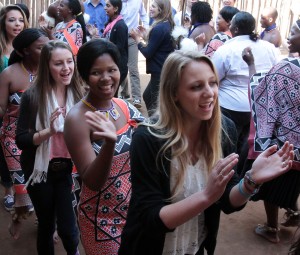
Another thing that I found interesting was that men always exited the huts before women. The idea was that in the event of an attack, the men would go out first so that they could defend the women. However, the hut itself had its own form of defense. The huts were built of sticks and covered in grass, but the grass was weaved in a way that if they were under attack, it was almost impossible for a spear to go through from the outside, but even a small child was strong enough to push a spear out from the inside. This was a really cool defensive idea because if the hut was surrounded the only way that the enemy could enter was through a very low door, yet anyone inside the hut was able to attack the enemy from a comfortable standing position.
On top of seeing their homes and getting an understanding of the layout of their village, they also performed some of their traditional dances. When they first came out the feeling was different from the other dancers that we had seen. While the other dancers came out seeming more carefree and looking really happy about the opportunity that they had, these dancers seemed like they were simply going through the motions of it. However, after their first dance, when we erupted into a storm of applause, they finally loosened up and really got comfortable with us. After they performed several more dances, we were surprised to be called up to the stage. Not only did we need to sing in front of the dancers, but also in front of an entire public audience that was there to see the Swazi performance. This moment made me realize just how much music really can bring people together.

Today we went to a cultural village in Swaziland. As we walked in, I noticed the thatched roof huts around me, and the simplistic nature of the area. Our tour guide, Paul, was dressed in the traditional Swazi attire, a long draped wrap on top and a wrapped cloth on the bottom. I really got the feeling of the Swazi tribal culture.
We had the privilege of watching one of their performances. They performed tribal songs and dances. I was amazed by the dancers, who kicked their legs up swiftly, following along to the drumbeat, while performing in their traditional clothing. I felt the vibrations of the drums and could not glance away from the interesting, new, Swazi dance. At the end of their performance, we got up on the stage and sang our songs. We were a little hesitant at first, but as we sang “A Si M’bonaga” we noticed the crowd, especially the indigenous people, smiling and clapping along. We ended with “Shosholosa”. The performers joined us and we danced around while singing. They were so happy to see us singing, and the smiles on their face made me smile too.
After our adventure at the cultural village and shopping, we returned to our dwelling. When I came down for dinner, I noticed there were a few guests. Soon I found out that they were two musicians there to perform for us. One of them pulled out his guitar, he was the singer, and the other one was a rapper. The first song they sang blew me away. Their songs were filled with emotion and meaning. Their lyrics really struck me. They sang about war, love, Swaziland, growing up fatherless, and many other hardships people face in the world. The two musicians were so talented. Right after they finished singing I started to hum along to the tune. The songs were catchy and expressive. After they completed the encore, another man stepped up and recited spoken poetry. It started out as a goodbye and transitioned into a poem about memories. The way he delivered the poem was beautiful and dramatic. It was a wonderful ending to our evening and time in Swaziland.

We went to the Mkhaya Game Reserve yesterday. Our experience there was more than I expected. It was incredible to see all the animals I was looking forward to seeing, while also hearing detailed information from our driver. Trevor Tutu also shared information about the animals we saw during a conversation afterwards. I was ecstatic to see the zebras with their mesmerizing stripes and the rhinos with their long horns. The elegant giraffes, adorable warthogs, and swift wildebeests were an extra treat. The day concluded with an amazing performance done by traditional dancers and singers from Swaziland.
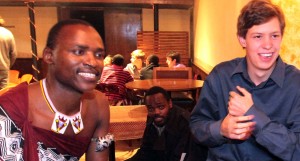
Today started out with a short bus ride to the House On Fire which is a small performance center, restaurant, Internet café and arts collective. The performance space consisted of a very eccentric theater filled with huge stone seats, and secret passageways to the balconies and sides. I was struck when I saw the looks of pure joy on my classmate’s faces while they ran around the area, discovering all the new excitement and adventures the little place held. After looking at a few small shops, we headed off to the cultural village where my class and I learned about traditional Swazi culture.
We had a basic understanding of Swaziland from what our teachers had told us about the country and we gained a bit more information from what the Swazi performers told us last night, but we had no idea about the depth of the rich history, culture and traditions of the Swazis. While the guide gave us a tour around the huts and other wooden structures a few of my friends and I talked about how this felt like a history lesson. Many of their practices, like using cows as dowries, and having multiple wives, are not something our culture is familiar with. While many Swazis no longer practice a traditional way of life, they still take great pride in their culture and history and some individuals have held onto certain practices. It was amazing and striking to know that even today some Swazi people live in a way that is so foreign to us.
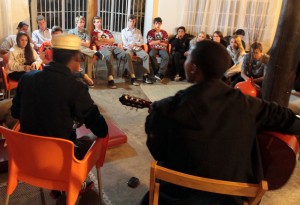
After a shopping adventure at a craft fair in the afternoon we returned back to the guesthouse. We were surprised at dinner when a group of three young men joined us. I became intrigued with the man with the interesting hat, the man with a bright jacket, and the man with the six strings on his back. Ward, Curtis, and I began talking with them at dinner. Through our conversation I came to find out that they were poets and musicians. I told them that I also write music. They asked the classic questions about California, our school, and our trip, but we soon began talking about what they are interested in and their paths in life. Qibho (hat), Themba (jacket), and Sands (guitar) were very interesting, and I was excited when Qibho and Sands prepared to perform for us.
The second they started I was blown away. The voice of Sands and the raps of Qibho were mesmerizing and quickly drew everyone in. The songs they write are incredible and soon, everyone was singing along to the lyrics that were in English. After the performance we talked some more and found out that we share many similarities. We now plan to talk and share music we have written. I cannot wait to hear more of what they have done and hear their reactions to my music.
Connections like this remind me of how unique this area is. I am not fully qualified to say this as I have not traveled the world and sampled many other cultures different than mine, but I have never been in a place where relationships, connections, and trust are formed and strengthened so quickly. Jay was talking tonight about how these might be created quickly because we have no time to waste. This could be a factor, but I also believe that it is in the blood of the people here. So many people trust each other and lean on each other for many different reasons and there is a strong sense of community wherever I go. I envy the presence of this in the places we have visited, and I will definitely miss it when I head home. America has not quite acquired the caliber of community that we have experienced, but I do believe that it is on its way. A few small changes from every person could create a presence similar to the one that has been so strong on our class adventure.

As long as I can remember giraffes have fascinated me. As a kid I wished that I had a pet giraffe; they seemed like an alien creature to me and I couldn’t help but want one as my own. With their long necks, beautiful round eyes, elegant eyelashes, bluish tongues, and unique patterns that no two giraffes share, I couldn’t help but be intrigued by them. In school whenever I had a chance to do a report on an animal of my choice, I picked the giraffe. No matter how many times I did a report on them I couldn’t get enough, and I was always captivated to learn more.
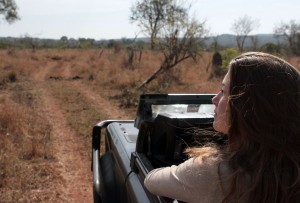
When we came to Swaziland I couldn’t wait to see these magnificent creatures in their natural environment. I had seen giraffes in the San Diego Zoo as a young child, and spent the whole time marveling at their beauty. When I went to Disney World, I stayed at the Disney’s Animal Kingdom Lodge and got to experience giraffes walking right outside of my hotel room at all hours. However I was excited to see them in their own environment rather than in a man-made environment created solely for the benefit of tourists. Our visit to the Mkhaya Game Reserve in Swaziland would be my first time doing this.
I was graced with the opportunity to sit in the front row of our Land Rover. The second the Mkhaya Game Reserve gate opened my eyes were pealed for giraffes. We saw other animals that interested me, but all along I was waiting for the exciting encounter with the giraffes. As we drove along the bumpy, reddish soil path, going over rocks and passing trees, all of a sudden someone pointed out giraffe heads looking down at us, watching very intently. Our driver Bongani stopped so we could admire them. As I looked up I thought about how I had been waiting for this moment for so long. My eyes opened with excitement. I looked into the eyes of what I had dreamed of seeing, a free giraffe that was in its own habitat. You could see how calmly yet intensely, they were looking at us, accepting us on their land, welcoming us with their exquisiteness. I felt like I knew everything about giraffes, due to all the research I had done on them including the report I had done for this trip, but I was mistaken.
Seeing the giraffes in their own habitat, interacting with one another in a way that is natural and uncensored, knowing that they are not being watched by thousands of people, cameras and zoo workers, was different from what I experienced prior to this. They moved fluidly and for the most part didn’t seem to mind us watching them. I was fascinated by the way they moved because they were so much bigger than I had imagined. Everything they did was distinct from the other animals in the reserve. They looked peaceful as they tilted their heads to eat the branches and leaves that no other animal could eat. I watched them and studied every move they made so I could completely engulf myself in their presence. I enjoyed every moment with them. As we left the tower of giraffes I felt satisfied. I had gotten the opportunity to see them in their natural habitat; something I had always dreamed of doing.

Today we participated in one of the most anticipated activities of our trip, a safari. I will not soon forget this experience. It started on a dirt road that our fearless bus driver, Mavis, led us down. The road was an extremely bumpy and harsh terrain, but Mavis navigated it like a pro. When we reached a riverbed, a small boy informed us that we were not supposed to drive the bus down there. We turned around and returned to the parking lot. Once there, a Land Rover Defender, that ran as silently as a ghost so as to not scare away any animals, awaited us. A man named Bongani greeted us. He was to be our guide for the day.
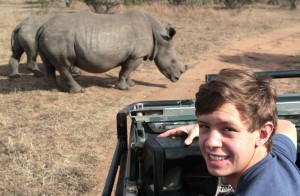
The way I see it, a safari consists of a few of my favorite things acting in concert to create an unforgettable experience. The first aspect of this is the off-road portion, where one gets to conquer roads, or the lack thereof, in a machine that is truly all-purpose built. The next part is the most obvious, seeing the animals. Seeing the animals was truly awesome. They are so graceful even in stillness, and each has its own quality that will enchant you and take full and complete control of your thought process. The third part, that truly brings the whole experience together, is the human interaction. This was made especially clear through my experience with the people whom I was sharing a vehicle with, including our driver Bongani. He was a master of plants, animals, driving, and being an overall super loveable guy.
The moment of the safari that I remember the most vividly, was one of our final moments on the reserve. We stopped at a watering hole on the way back to our bus. It had the most amazing view that any safari goer could hope for. It was an enchanting lake, with glass still water. On the opposite bank we saw three rhinos, three giraffes, and a family of warthogs, who were later replaced by impalas bounding through the tall grass. This last experience was a perfect ending to our time on safari.
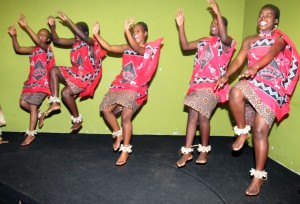
Later on in that action packed day, Ward told us that we were going on another adventure to a theater club. Once there, we would have the opportunity to interact with some Swazi people. We had a very interesting Q and A session. During it, I noticed a particularly inquisitive man and I invited him to have a conversation over dinner. His face immediately lit up and he looked like he had won the lottery. He was so excited to talk to me that he completely forgot to get dinner until a man approached him and made him get some food. The questions that he asked me really helped me to understand him and his culture a lot more. The things that he asked seemed so simple, but they really showed me how little I knew about Swaziland. Any misconceptions he had about America, I had a thousand more about his culture. We covered so much content. Soul also joined the conversation and was really good at helping explain things that I had trouble with.
The first thing he asked me was whether or not Canada was a part of the U.S. Later we went on to discuss the system of presidential elections, the production of films, and how it was possible that human beings could survive in conditions where there was snow and ice. At the end of the night, we exchanged e-mails and I gave some of the strongest hugs I have ever given. I can’t wait to contact him because I am sure that every time we talk there will be a great exchange of knowledge in store.
Click on the gear icon at the bottom of the video after starting to play to set it to high definition.
Video filmed and edited by Devin Kumar.

When I first spoke to Julius he was sitting alone on a bench, eating his oatmeal, isolated from everybody else. I decided to walk up to him, sit down and say, “Hi Julius.” Julius was our bus driver and he became a very dear friend. Yesterday he told us, “Most of the time people treat us as if we are invisible…you guys have really touched my heart”.
People like our bus drivers and cooks are the type of people who are often overlooked. They deserve much more credit than they’re given. I’m really proud of my class for giving these people the respect they deserve and making sure that our group is remembered fondly.
Unfortunately, before our trip to Swaziland, Julius started to feel unwell and was not able to accompany us. We said our goodbyes in Soweto and told him we would stay in touch. He assured us that he would be fine and told us not to worry. We miss him immensely and hope he makes a speedy recovery.
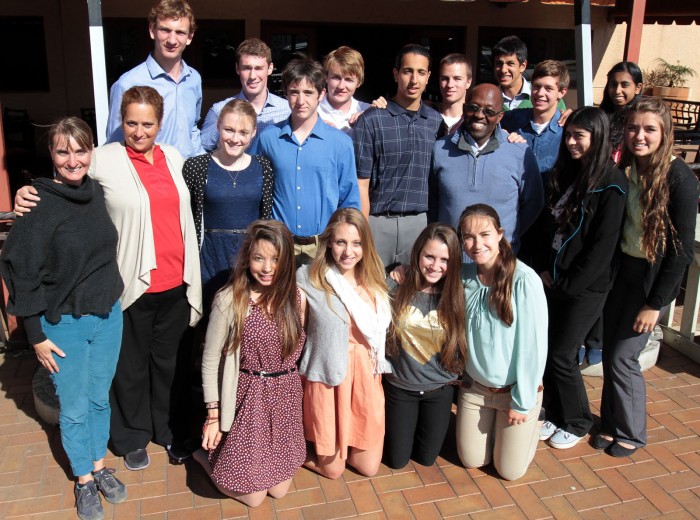
Dear Readers,
We arrived in Swaziland on Friday afternoon. We are staying in Mbabane, the capital city of Swaziland. The internet here is rare and this is our first chance to get something out. All day Saturday we were out on Safari at Mkhaya Game Reserve. In the evening we had a great Swazi cultural experience as well. Stay tuned for student writings and photos.
At your service,
“Team Media”
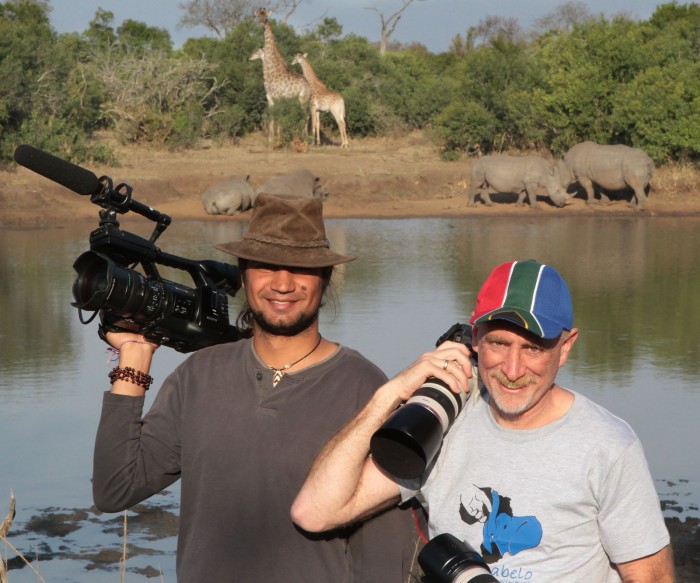

Cages, fences, concrete walls, and ceilings; these are all things that one would see in a prison. At the Apartheid Museum there was a feeling of imprisonment, a sense of not being free. At the museum it was interesting to trace the history of an era of injustice.
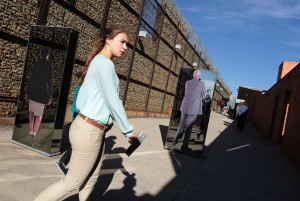
I have always been fascinated by history because it gives me a greater understanding of why things happen. On this trip I wanted to learn about the origins of Apartheid. I wanted to know how a people such as the Afrikaners could experience oppression by the British, and then turn around and oppress another group. I also found it interesting how even though they are on the other side of the world, South Africans have a very similar history to us. In trying to understand Apartheid I was lucky enough to get many different perspectives. I spoke with people such as F.W. de Klerk, Peter Harris, Pregs Govender and Chené, Ward’s friend. I learned that there are many little pieces of the puzzle, but one major factor that drove Apartheid was fear. This is what I have gathered throughout this trip.
The Afrikaners are the descendants of the Dutch that colonized South Africa. When the Dutch power faded the British came to try to prevent the area from falling into French hands. The Afrikaners resented the British presence and felt that the British were oppressive. When the British issued the end of slavery, the Afrikaners moved north to keep their slaves and they started their own government. The British did not pursue them until the discovery of gold and diamonds. Once this happened the British invaded. During this time many Afrikaner women and children died in concentration camps. As a people, they developed a mentality to self-reliance and fear of losing their independence. This mentality also helped create a fear of outsiders.
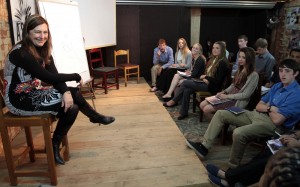
From talking with Chené and going to the Apartheid museum I learned the power of this fear and what it developed into. In the Apartheid Museum I saw how they had this fear of being overrun and losing their culture. They also had this idea that the native Africans should live in homelands. They called this separate development. The different native tribes were given poor lands closed off from each other. The native Africans also lost their right to vote because the Afrikaners felt that people without education shouldn’t govern a country. The government used the story of the Tower of Babel to to justify the idea of separate development. They said that when God made everyone in the tower speak different languages it meant that we are supposed to live separately.
Throughout the years the Apartheid government became more and more radical. It’s policies created extreme poverty. Photos in the Apartheid museum showed the brutality of the government. They showed the police attacking protesters, the horrible living conditions in the townships, and mindless rules created during that era. For example, if a black doctor wanted to have a cup of coffee he would have to walk all the way home and drink it there. Cafes would not serve him. In medical school it was illegal for blacks to touch white cadavers. A concrete wall in the museum shows photos of all of the different acts passed by the Apartheid government. Most of these laws were passed in the 1960’s. That was possibly the most shocking thing to me, how they passed all of these acts in such a small period of time. It made me feel constrained. It was in this period of time that the anger of the oppressed grew and eventually turned into political movements.
When I first came here to South Africa I was curious to know the culture and a bit about Apartheid. Through my many conversations I have learned about the complexity of the history. It fascinates me.

We’ve learned a lot about South Africa in the time that we’ve been here. I’ve been most interested in the Apartheid era and how it came to an end. We visited the Apartheid Museum today and I found it very fascinating. As expected, the museum revolved a lot around Nelson Mandela, but at the same time emphasized the importance of others during that era, such as Steven Biko and Chris Hani. We had done tons of research on Mandela and were overwhelmed by everything he had experienced and accomplished. Visiting the museum was a reminder of the difficulties that a large population of people went through for numerous years.
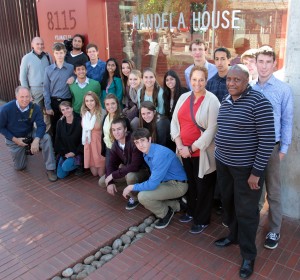
Trevor Tutu, son of Archbishop Desmond Tutu, met us at the museum. He had many interesting things to tell us about South African history and Apartheid. He also introduced us to the curator of the museum. It was fascinating to learn about the design and process of building the museum.
The day we visited the Apartheid Museum and Soweto many camera crews and reporters were camped out in front of Mandela’s house in Soweto waiting for his passing. Many people thought that he only had a couple hours to live, however, as I write this he is still in this world. I’ve gained a tremendous amount of respect for him over the last year. It began when I read his book Long Walk to Freedom, and has continued to build, culminating in our visit to the Apartheid Museum. I will forever remember the great qualities he possesses and view him as a great inspiration and leader.
Click on the gear icon at the bottom of the video after starting to play to set it to high definition.
Video filmed and edited by Devin Kumar.
Click on the gear icon at the bottom of the video after starting to play to set it to high definition.
Video filmed and edited by Devin Kumar.
You must be logged in to post a comment.